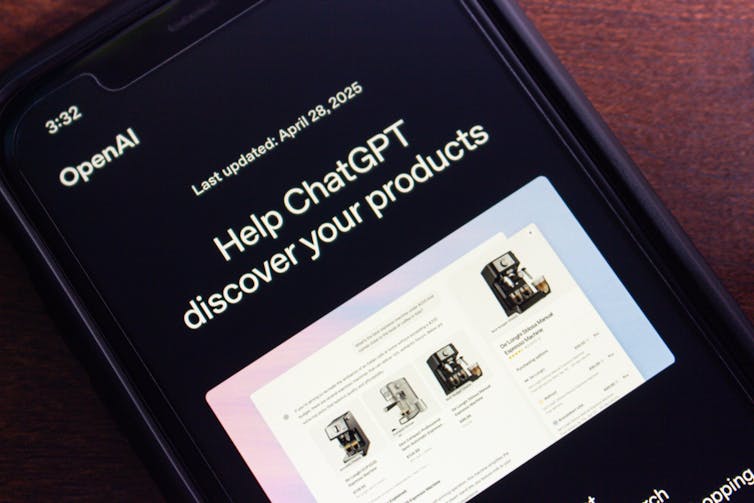Source: The Conversation – UK – By Rachel Rosen, Professor of Sociology, Social Research Institute, UCL
Miriam was 13 when we met her. One day, she asked Eve: “How can we help my mum? She really struggles. I worry that we don’t have enough money for food and stuff.”
Miriam went on to explain that her mother would often skip meals to make sure the children could eat. “Normally we don’t have enough food. So, if there’s a little bit, she’ll give it to me and my brothers, and then she just has tea or something.” Later, Miriam’s younger brother Luke, 11, told us that the children also missed meals.
The family of four lived in a small, two-bedroom flat owned by a private landlord in London. As they took us on a video tour, we heard that the heat was intermittent and large holes were visible in the plaster behind a heater next to the toilet. Miriam explained that the heater had broken but the landlord had not replaced it, despite the cold and damp London winters.
Other signs of disrepair were evident around the flat. The lights in the older children’s room had burnt out over a year ago. The children used the torch on the family’s mobile phone to see when it was dark.
The kitchen sink was blocked and had to be drained manually. Any time the family washed dishes or prepared food, Miriam and her mother Serwah would have to run between the sink and toilet with a bucket, emptying it before the flat flooded. Even the smallest of everyday tasks became large and arduous responsibilities.
The family had lived there for three years, and in London for over ten, but they had limited options to improve their circumstances.
The Insights section is committed to high-quality longform journalism. Our editors work with academics from many different backgrounds who are tackling a wide range of societal and scientific challenges.
Serwah had come to the UK from Ghana with the hope of making a better life. After arriving, she realised that she had been made false promises and life was “not good like that”. She found herself struggling in a difficult relationship with a man who was a “liar” and had “destroyed everything”. Serwah ended up being undocumented, but had recently been granted “limited leave to remain” with “no recourse to public funds” (NRPF).
No Recourse to Public Funds
NRPF is an immigration condition contained in the UK’s Immigration and Asylum Act 1999. It states that migrants “subject to immigration control” are not allowed to access most welfare benefits, social housing, or other support, such as extended childcare services.
According to figures analysed by the Migration Observatory at the University of Oxford in 2019, around 1.376 million people with time-limited “leave to remain” (including students, people with work visas, and those on family visas) are subject to NRPF in the UK. A further approximately 674,000 undocumented people have NRPF imposed by default. Research shows that NRPF particularly affects families who are already economically and socially marginalised, such as single mother households and racially minoritised families from Britain’s former colonies.
Charities suggest that at least 382,000 children in Britain are forced into deep immiseration by NRPF, just like Miriam and Luke. For families like Serwah’s, it means that no matter how impoverished the family is, next to no social support is available, and other options for getting by are also heavily restricted.
NRPF is a less visible and spectacular display of the way various UK governments have approached “controlling immigration”. It has not caused the same controversy as the “Rwanda scheme” or plans to house asylum seekers on a decommissioned barge (what migrants justice groups called a floating prison for people seeking sanctuary).

Shutterstock/Zeynep Demir Aslim
But the families we have met in our long-running research about NRPF explain that its effects are every bit as brutal and drawn out.
Over the past six years, we have worked closely with 25 single-mother families living in the shadow of this policy. We have participated in families’ daily lives, conducted interviews, and invited children and adults to take photos, journal, and lead us on video tours. Our research has been in-person and online (especially during the pandemic). We asked participants to choose pseudonyms. Confidentiality is important in all research but crucial for their families given their precarious status.
Hopes for a better life
There was never a single reason within a family, or even for individuals, as to why they had come to the UK. Many of the children were born in the UK while others were brought by their parents at a young age. Some mothers had come attempting to flee abuse while others hoped to make better lives, describing conditions of extreme poverty in their own childhoods. Some had come on visitor visas for short trips to see friends and family but had ended up staying as their situations changed (for example, unexpectedly starting a family or having a child who suddenly needed specialist medical treatment).
What was similar for our participants was that leaving the UK was not really an option. In most cases, this was because their children were British and mothers did not want to uproot their lives. The mothers we met had also been in the UK for over a decade, and despite the hardships they faced, felt that it was home. In some cases, the abuse, extreme poverty, or violence which had compelled their immigration in the first place had not diminished. In others, debts incurred to enable immigration or to survive in the UK would be insurmountable in their countries of origin.
Regardless of how and why families were in the UK, their experiences raise questions about how the UK treats them – and that is the focus of our research.
The families we met told us that despite their best efforts to make liveable lives, the cold bureaucratic language of NRPF masks a hard reality of long-term suffering, enforced destitution, and extensive and intensive labour, simply to survive day-to-day.
We found that NRPF is forcing some single mothers into a state of hyper-exploitation where they are forced to carry out cleaning or childcare for little or no pay, and subjected to verbal and physical abuse. Many families wind up homeless or dependent on the kindness of friends or strangers who are often in similarly precarious situations.
NRPF is even imposed on British citizens: children who get dragged into it because of their parent’s immigration status.
Serwah, Miriam and Luke: ‘constantly feeling hungry’
Serwah had “limited leave to remain” and was legally able to work. But without access to affordable childcare, Serwah had to depend on friends or acquaintances to care for her children. She is not alone – according to a report by the Institute for Public Policy Research, tens of thousands of children in migrant and refugee families are being denied access to government-funded childcare because of NRPF linked to their parents’ immigration status. Serwah’s friends were often in equally precarious positions.
As a result, they were reliant solely on Serwah’s wages from twice weekly night shifts in a small residential facility assisting people with dementia while her friend cared for the children. The family found themselves deep in debt. Months of rent arrears due to their destitution had left the family with limited legal options to ensure that the private landlord provided adequate heating, water and other necessary utilities.
For children like Miriam and Luke, who have never lived anywhere except the UK, NRPF means a life of destitution – constantly feeling hungry, trapped in uninhabitable accommodation and without necessities. Yet, they are typically expected to participate and perform in school the same as other children and even punished when they don’t. For example, children have been threatened with missing important school activities if their parents owe money for school meals, while others have been sent to detention for failing to wear the proper uniform because the family cannot afford it.
During another visit, Miriam explained that she usually did homework on the family’s shared mobile phone in the crowded flat. “I don’t really talk to people about my problems. I just keep it to myself”, she said. She explained how hard it was to talk about the family’s situation and that she felt unable to seek assistance from teachers.
Boris Johnson’s surprise
There was a rare furore around NRPF in 2020. At the height of the COVID-19 pandemic, then prime minister, Boris Johnson, revealed his own surprise at the policy’s existence. Responding to questions about how a family with the legal right to remain in the country would survive without furlough pay and with no right to benefits, Johnson commented:
I’m going to have to come back to you on that because clearly people who have worked hard for this country, who live and work here, should have support of one kind or another. You’ve raised a very important point … If the condition of their leave to remain is they should have no recourse to public funds, I will find out how many there are in that position and we will see what we can do to help them.
Johnson’s political gaffe (not being aware of his government’s own policy) was largely interpreted as an example of his own incompetence. But his initial reaction indicates how little is known about this policy – a visa condition which puts Britain’s “universal” welfare system out of reach of so many.
In public debates, NRPF is often presented as a rational and reasonable way of “controlling migration”. In 2011, when Home Secretary Teresa May expanded NRPF to include migrant families who had had been granted “limited leave to remain” on the basis of Article 8 (rights to private and family life), she stated:
What we don’t want is a situation where people think that they can come here and overstay because they’re able to access everything they need.
May’s claims were echoed in tabloid headlines of the time, which screamed about the “Human Right to Sponge Off UK”.
Article 8 rights had previously accorded migrant families the right to both stay and access social support alongside other UK residents. As a result of May’s changes, migrant families were placed on the ten-year-route to settlement with NRPF for the duration. The ten-year-route requires four separate applications for temporary status to be made, before applicants can apply for permanent residence. Every two and a half years, applicants must pay £1,321 (per family member) plus a £2,587.50 surcharge – again, per person.
The language of “securing borders” against “spurious” family claims echoes in the government’s current White Paper on immigration. Yet, this is a “problem that does not really exist”, according to barrister Jamie Burton who says the burden of proof is already very high in Article 8 cases.
The policy also doesn’t seem to make financial sense. A social cost benefit analysis conducted at the London School of Economics suggested that removing NRPF for households with limited leave to remain on their work-related visa would result in net gains for Britain of £428 million over a ten-year period, due to reduced costs for the NHS, local authorities and increases in tax revenue. This increases to £872 million if applied to families with children.
While this study shows the financial feasibility of jettisoning NRPF, the logic of a cost-benefit analysis roots Britain’s cost-of-living crisis with destitute migrants, rather than asking why wealth is so concentrated or discussing the ethical principles of a policy which leaves children in fear of starvation.
Destiny and Isaac: fear of starvation and homelessness
Isaac is just one example. He was 13 when we met him and was born in London. He lived with his mother Destiny in a shared room. The room was under sloping eaves and packed with their two single beds and a protruding wardrobe containing all their possessions. Filled with their drying laundry, it felt particularly small and claustrophobic.
Destiny, originally from Nigeria, had limited leave to remain in the UK with NRPF. Isaac was a British citizen, yet the NRPF restriction on his mother’s visa also affected him – a clear example that the policy doesn’t achieve its own logic of protecting “British resources” for British citizens.
Isaac felt keenly that a “universal” welfare system that is not “for all” is discriminatory. He explained:
England is a multicultural country [but NRPF is] basically screwing over those people who came from different backgrounds … as it only favours a certain type of people … It doesn’t favour the whole of Britain.
The fact that NRPF was “basically screwing over” racially minoritised people was not just an abstract idea for Isaac. It was both a hard physical reality and a cause of deep anxiety. “I was worried that we didn’t really have food, if I was going to eat the right amount of food or if I was going to starve,” he told us.
Many of the children we spoke with, like Miriam, worried that if they spoke to anyone about the family’s situation they would be stigmatised or their mothers might be blamed for their destitution. Unusually, Isaac decided to reach out to his teacher for help. His fear of the family starving trumped any concerns he might have had about speaking out.
He described his relief when his head of year helped the family access food banks that were not limited by immigration status, so they didn’t “have to stress about food”. Yet even that relief was only partial, he explained.
Worrying, that puts like dark scenarios in my mind … And I thought like the worst-case scenario would be living on the streets, and I wouldn’t really go to school …
Isaac’s insights about the persistent and grinding effects of NRPF, even when a little bit of relief was available, were echoed by many of our participants.
Samantha and Sam: ‘It destroys you mentally’
Samantha was sitting on the sofa during one of our first meetings, wearing a grey wool hat. She called her eight-year-old son Sam over. He looked excited when his mum said he could “choose a secret name” if he took part in the research. After some whispering and laughter, the two settled on Samantha and Sam.
Eighteen years before we met her, Samantha had come to the UK from Nigeria, joining her parents as a young teenager (around 13). She only discovered as an adult that she had no legal status in the UK and therefore was subject to NRPF. Describing the long-term affects, she said:
It destroys you mentally. And if you’re looking after children, who are depending on you to be a pillar of strength and depending on you to guide them, look after them, and everything, you can’t afford to lose yourself. And that’s what no recourse to public funds does to people. You lose yourself. You lose your sense of identity.
For Samantha, Serwah, and other mothers we spoke with, virtually the only sources of support lie with people in equally precarious positions. Like their children, many mothers find it difficult to ask for help and any help is fragile at best. Asking for help has “always come back to bite me in the backside,” Samantha explained, “So I’ve just soldiered on.” She added: “I had no one to fall back on, I had no one to rely on.”

Shutterstock/Ascannio
On one occasion, Samantha mentioned trying to keep costs down when she was working cash-in-hand by asking an acquaintance to help her with childcare and paying the woman what she could afford. The arrangement ended traumatically when she found scratches all over Sam’s body when he returned home one day.
Unable to access government support forced her, and many of the other women we spent time with, to endure relationships and situations that were harmful and painful for them and their children.
By the time we met Samantha, she described having a small feeling of relief. Things had been very difficult for many years, but had recently eased up a bit. They were still undocumented but had recently been able to secure local authority support which included the provision of a small, two-bedroom house.
Though not originally intended for the purpose, local authorities can provide accommodation and financial support to some families with NRPF under Section 17 of the Children Act 1989. Data from the NRPF Network shows that at least 1,650 families (comprising 2,903 dependants) were supported by 72 local authorities across the UK, as of March 31, 2022..
In practice, Section 17 support is minimal, challenging to access, and is often conditional on accepting difficult requirements, such as moving far away from carefully nurtured social networks or to inappropriate, or even hazardous, accommodation.
Although Samantha and Sam showed us the house with evident pleasure, they had initially been reluctant to accept it because it was outside London where they had been living and where Sam had been going to school.
Samantha was so worried about maintaining continuity for Sam that even after moving, they continued to make long journeys back to his school. “That was costing a lot of money. It was physically and mentally draining,” Samantha said. She eventually moved Sam to a new school closer to the new home.
For other families with NRPF, trying to access Section 17 assistance can be a punishing experience.
Martha and Mobo: racism and disrespect
Martha, who had come to the UK from Nigeria as an adult, was staying with her uncle and cousin when we first met her. She shared one room in their two-bedroom house with her three sons, Kevin, 18, Mobo, 16, and Tayo, 14. The small room was filled with a double bed, a folded cot, and a wardrobe. There was little room to move. The “whole family is just cramped up in there”, Kevin said, describing how the family of four shared the space, meaning someone always had to sleep on the floor.
The family got by on a patchwork of support. An auntie paid for a telephone and lunch fees for the children. Members of their church provided them with food and friends from back home sent Martha clothes.
Martha had considerable caring responsibilities for her youngest son, Tayo, who was visually impaired. On this basis, she had recently approached the council for Section 17 support. As she was explaining Tayo’s highly specific needs (the subject of the child-in-need assessment), the social worker just hung up on her, she explained.
Reflecting on his mother’s experiences with social services, Mobo used the word “disrespect” repeatedly. He explained that his mother was treated as though she was “stupid”, but at the same time as if she was “suspicious” because of “stereotypes of what a needy person should look like”.
The entire experience of seeking child-in-need support from the local authority was “hurtful”, “mean”, and deeply racialised, Mobo said. His mother was subjected to “negative stereotypes”, he told us, linking this to the way that “African countries and black nations as a whole” were depicted. “… It’s usually just the bad stuff that makes the news,” he said. Such sentiments were echoed by other children.
Tanya: abused and exploited
Meanwhile, being subject to NRPF for a long time can also make people vulnerable to threats and exploitation, as Tanya told us. Tanya answered the phone with a friendly and open tone when Eve first reached out to her. She was in her early twenties and had come to the UK from Jamaica as an 11-year-old to join her parents. Just like Samantha, she only discovered that she did not have legal immigration status in the UK when she was an adult.
Tanya was making what is often called a “half-life application” because she was between 18 and 24 and had lived in the UK continuously for more than half her life. Yet even if her half-life application was successful, she and her two small children (aged six months and two-years-old) would face another decade subjected to NRPF on the ten-year route to settlement. She told us: “It’s not an easy thing when you don’t have papers in this country for so many years; it’s a struggle.”
“It’s so frustrating that I’ve been here for so long. I went to school here.” Tanya did not know why her mother had not sorted out her immigration status when her own was settled and this subsequently made their relationship fraught.
She described how she was staying with a “friend” rent-free, but that came with strings attached.
Tanya was expected to do all the housework and childcare for both families, even when she was exhausted and heavily pregnant. “I take her kids to school. I clean the house every single day, seven days a week, never get a break to myself when I was pregnant with my daughter.”
It wasn’t simply that NRPF meant she couldn’t afford accommodation of her own. But being undocumented affected every single aspect of her life. “There are limited things that you can do,” she said. “Like, you want to go and get a bank card? You can’t. The first thing: have you got any form of ID? … No, you don’t have it. Oh, you can’t get this.”

Shutterstock/y.s.graphicart
The woman she was staying with would often abuse Tanya verbally, telling her that she should not have come to Britain and that she should be “locked down” because she didn’t have her papers. Tanya felt hurt and taken advantage of, but she had nowhere else to go and feared being told to leave. “I would take the abuse, like take it, take it, take it”.
This was a common experience for mothers in our research. They told us repeatedly that asking for help was not something to be undertaken lightly because it always ran the risk of opening them up to hyper-exploitation. Some told us there were expectations of repayment through sexual favours, or punitive and paternalistic demands for gratitude.
Like Tanya, mothers and children often had to stay in situations that were clearly painful, deeply exhausting, and dangerous because they had been effectively abandoned by the state. Many faced these situations over extended periods of time, regardless of how long they had been in the country and whether they had legal immigration status or even citizenship like Isaac.
It wasn’t simply the material reality of NRPF that stung Tanya. It was having “people look down on you a lot”.
She told us about the constant struggle of growing up in Britain yet constantly being made to feel as though she did not belong. “People look at you: ‘so what are you doing in my country then?’ As if you’re just taking up space …”
This sense of “just taking up space” echoes the tabloid rhetoric that was used to rationalise NRPF and call for its extension. Yet in listening to our participant’s stories of their lives, we are struck by how far this is from their reality.
The enforced destitution caused by NRPF required extensive labour simply to survive day-to-day – from Miriam and Serwah’s continual emptying of the sink that would not drain, to Tanya’s backbreaking housework in exchange for a bed, to Samantha and Sam’s long journeys to get to school.
But this idea of “just taking up space” is almost absurd when we think about the tiny spaces families with NRPF are forced to occupy due to their impoverishment. It was not uncommon to hear about families of four sharing a single room or living room floor, entirely dependent on the hospitality of friends or strangers.
For example, Shanice, 16, had never slept apart from her mother and rarely in a bed of her own. She told us longingly about her dream of having a space of her own:
If you’re constantly sharing a room with someone, you can’t get time to always be yourself and just do what you want to do. We’re both different people and we both move at different paces … Being by myself just means a lot. Like, it means a lot to me just to have my own time to reflect…
Yet the feeling that Tanya described as being seen as “just taking up space”, combined with a complete absence of social support, served as a constant reminder to these families that they were not wanted in the UK.
Our participants repeatedly conveyed the sense of a persistent wearing of body and soul – what Samantha referred to as “losing yourself”.
Abiola and Akin: hope in a shoebox
But despite the hardships and the rejection, many refused to give up hope. People like Abiola. It was a cloudy January afternoon when Eve first met Abiola in person. Abiola was from Nigeria and had been in the UK for 12 years. She was undocumented and subject to NRPF. As a result, her ten-year-old son Akin, who was born in the UK and was a British citizen, was affected as well.
Abiola was waiting for her immigration application for limited leave to remain as a parent of a British child to be decided by the Home Office. But she had been aware of the high cost of regularising their status in the UK since Akin was young.
Despite their destitution, Abiola realised that she had to begin to save for Akin’s citizenship application. “Bit by bit, I opened a box. A shoebox. I made into something like a safe. And I started dropping money inside that place for four, five years,” she said.
She described how any support from her ex-boyfriend would go into the box as well as little bits of money she earned from her jobs: “The least I’m dropping is £5. Because I didn’t want to drop pennies in it. But there will be times in a whole month where I might not even put anything in that box.”
The shoebox with her savings was not just a safe; it symbolised her hope and dreams. Abiola continued:
Everywhere I go, I take that box with me. I didn’t touch it. I kept it. Even if I’m starving, I didn’t touch that money. Even if I was desperate, I didn’t touch that money.
She believed the money would “save her”, adding: “… I was hoping. This is where the future is lying. You have to save for it and get out of this condition, and live a better life.” She said:
I’m just living here. It’s hard … If you look at the way I’m living. There is no bathroom door there. If we are showering, the water is always on the floor. We have to be mopping it … Even if my son is eating, he sits down on the floor and he bends his head to the ground. I cannot even afford anything to make him comfortable. He reads or writes … lying down on the floor. It’s not an easy life.
Her resolve to save in the face of such extreme impoverishment was more than just an act of survival; it was a refusal to “lose herself”.
We heard similar stories from other families. Miriam spoke about the children doing all they could to make her mother “proud”. Speaking about Serwah, she said: “Because she’s struggled a lot for us, so when she gets old, we, all three of us, wanna make her proud”.
Meanwhile, Isaac nurtured hope by imagining a future where he could help others who were in the same situation that he was in.
No recourse is no solution
Our research shows that the no recourse to public funds policy makes life impossible for those who are subjected to it.
It is not a spectacular display of immigration control and rarely makes sensationalised headlines. Instead, the hardship produced by this policy is often experienced in the shadows.
The results of this bureaucratic immigration category are endured in the routine of everyday life, year after year. It often remains invisible – even to teachers, healthcare providers and co-workers.
Yet the stories of these families show that the imposition of this draconian immigration rule has done nothing to meet the government’s stated aim of protecting “the economic wellbeing” of the UK – at least for the most marginalised.
In 2022, 1 million children and 2.8 million adults in the UK were living in destitution. These figures include families with no recourse to public funds who typically experience the most extreme levels of deprivation of all.
If NRPF is not a “solution” and simply penalises and punishes those who are subjected to it, then the question must be asked, why do we have it at all?
For you: more from our Insights series:
To hear about new Insights articles, join the hundreds of thousands of people who value The Conversation’s evidence-based news. Subscribe to our newsletter.
![]()
Rachel Rosen receives funding from British Academy, ESRC, ISRF, and Nordforsk.
Eve Dickson receives funding from British Academy, ESRC, and Nordforsk.
– ref. Homelessness, fear of starvation and racism – destitute migrant mothers and their children on the reality of life in the UK – https://theconversation.com/homelessness-fear-of-starvation-and-racism-destitute-migrant-mothers-and-their-children-on-the-reality-of-life-in-the-uk-263552









